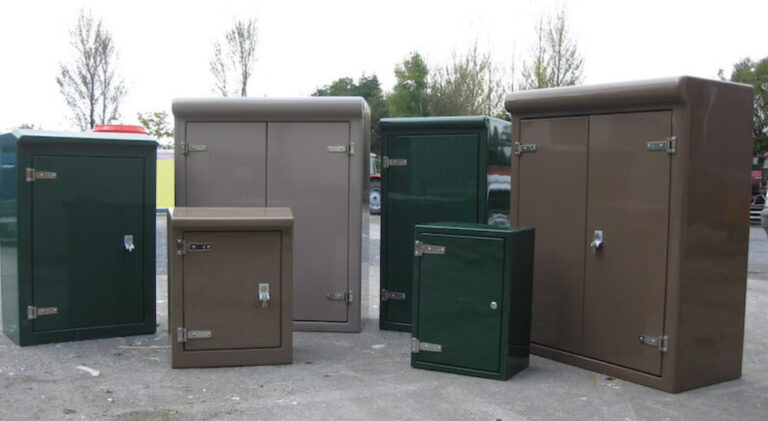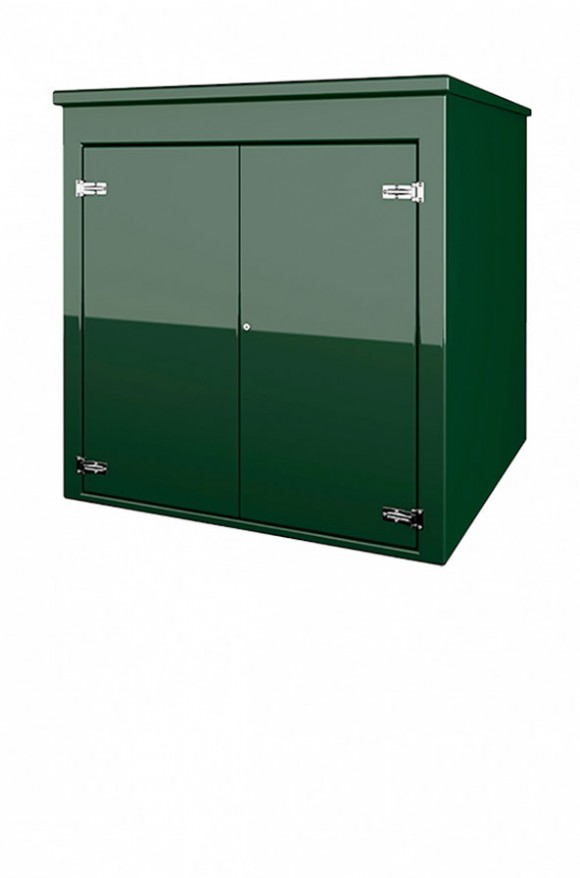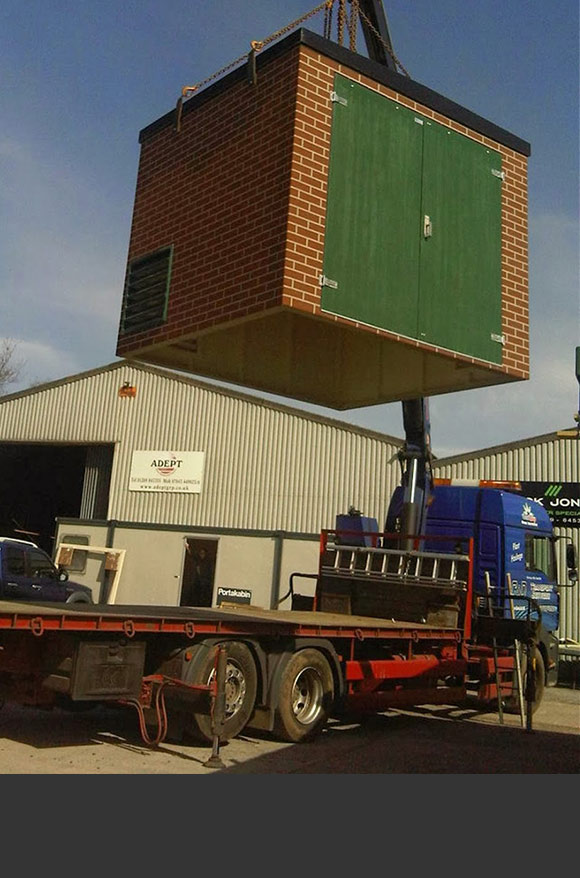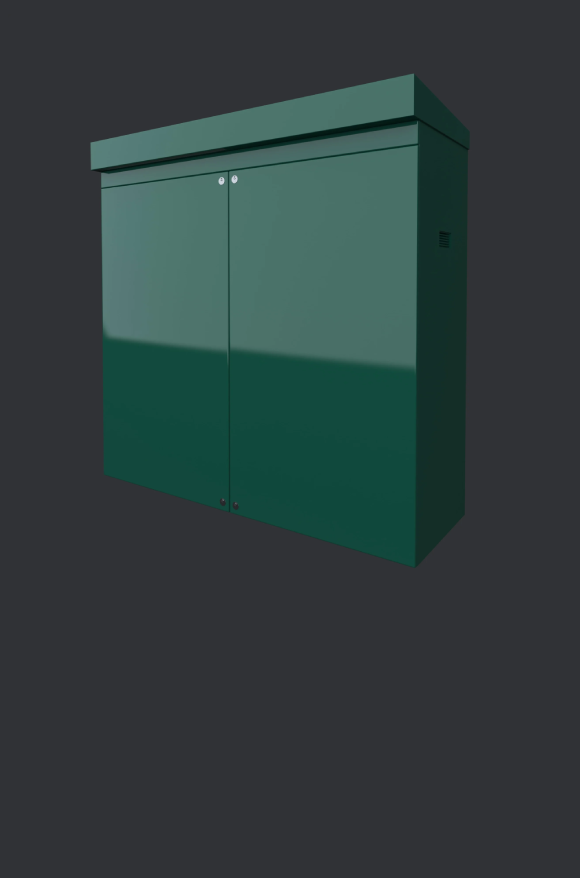Stumbling upon GRP enclosures might not be an everyday occurrence unless you’re aware of their widespread use. Found in industrial sites and even in residential spaces, these sturdy structures play a significant role. In this blog post, we’ll delve into the diverse applications and industries where GRP (Glass-Reinforced Plastic) enclosures prove their versatility.
So what are the applications of GRP enclosures and where are they commonly used? GRP enclosures are commonly used in various industrial, commercial, and residential settings. They are often used to protect electrical and mechanical equipment in outdoor or indoor environments. Some common applications include but are not limited to pump houses, renewable energy projects, telemetry control stations, sprinkler control stations, garages and storage units. Additionally, they can be customised for gas or electrical substations and provided with explosion relief roofs if specified.

Industrial firms widely favour GRP enclosures owing to their exceptional qualities, including insulation and durability. These enclosures offer highly effective protection in industrial settings, where the housing of electronic equipment is often challenged by frequent exposure to chemicals, moisture, heat, or cold temperatures.
The customisation capability of GRP enclosures stands out as a key advantage. Tailored to specific requirements, these enclosures offer various fixing options, such as free-standing frames or wall supports, ensuring maximum stability. Full electrical fit-outs can be seamlessly incorporated based on specified needs.
In industrial applications like pump houses, where sewage pumps operate under high pressure and flow rates while handling raw sewage and slurries—a task unsuitable for metal or concrete buildings—GRP enclosures emerge as an ideal solution. The materials used boast resistance to advanced corrosion and exhibit antimicrobial properties, mitigating harmful side effects associated with sewage handling.
An additional noteworthy advantage in industrial settings is the resilience of GRP enclosures to harsh environmental conditions, including wind and snow loadings. This durability proves invaluable when the enclosure is exposed to severe weather. Moreover, in contrast to traditional building materials like bricks or steel, which necessitate regular maintenance cycles, GRP enclosures demand minimal upkeep as they remain rust-free, water-resistant, and impervious to UV rays. Given these multifaceted benefits, GRP enclosures have become the preferred choice for industrial firms seeking top-tier protective solutions.
Composite materials are widely used in the energy sector, both for fossil fuel-based energy generation and renewable energy applications. Wind turbine blades are a major consumer of composite materials, often made from infused fibreglass composites or reinforced with pultruded carbon fibre composite spar caps. The worldwide investment in various clean energy technologies witnessed a remarkable 40% increase in 2023 compared to the figures from 2020. [R]
GRP enclosures play a crucial role in renewable energy projects. For instance, they are utilised to protect electrical control systems used for solar panels, wind turbines, and hydropower plants. GRP enclosures provide insulation from extreme weather conditions like high temperatures, humidity, and corrosion caused by saltwater environments.
Solar panels depend heavily on the durability provided by GRP enclosures. They protect components within the system from heavy rain, ice formation that can cause damage due to expansion or contraction of surfaces adhering together. These enclosures also keep out animals or debris that could impair normal operation.
Imagine a solar panel installation located near an animal habitat where rodents can pose a constant threat to panel wiring. A GRP enclosure would not only offer protection but also have adequate ventilation space to keep internal electronics cool -thus reducing the risk of overheating.
GRP enclosures demonstrate extensive utility in safeguarding substations within harsh and exposed environments. Substations, pivotal in electrical systems, play a crucial role in converting high-voltage electricity into low-voltage power for distribution to homes or businesses.
In the context of substations, GRP enclosures present a myriad of advantages. They effectively reduce noise levels in residential areas, incorporating sound attenuation features to minimise disruptions caused by electrical equipment. Furthermore, these enclosures are designed to prevent electrical arcing, a potential hazard arising from loose wiring or faulty equipment, thereby ensuring the safety of the surrounding environment.
Think of GRP enclosures, providing not only structural integrity but also environmental resilience. The robust construction of GRP enclosures serve against external elements, making them a dependable solution for securing substations in environments where durability and safety are essential.
Equipped with a variety of protective features, GRP enclosures stand out as the ideal solution for environments marked by challenging conditions. The inherent characteristics of the material render it resistant to extreme weather, water, chemicals, fire, and impacts. Take, for example, offshore wind turbines exposed to saltwater and high-force winds – the flexibility of GRP enclosures enables them to withstand vibrations and movements. Additionally, manufacturers purposefully engineer these electrical housings to resist UV rays, ensuring a sustained professional appearance even in the face of severe weather conditions.
The telecommunications sector, reliant on sturdy and secure structures that withstand adverse weather, finds a valuable ally in GRP enclosures. These enclosures, crafted from GRP materials, provide protection against corrosion induced by salt-laden air.
Similarly, the aviation industry, road networks, and rail infrastructure necessitate specialised control boxes capable of enduring challenging environmental conditions. Take, for instance, railway signals that demand robust yet flexible structures to mitigate potential risks to passersby.
Companies specialising in GRP for cable pits offer tailored solutions designed for robust performance in various soil conditions and locations. This adaptability makes them suitable for applications ranging from sewage pumps in commercial buildings to critical infrastructure installations.
GRP enclosures have demonstrated their efficacy in hazardous environments, such as chemical manufacturing plants requiring explosion relief features. Enclosure manufacturers can craft ultramodern housing units tailored for diverse industrial applications, ensuring safe and reliable performance even in adverse conditions.
GRP enclosures are favored across various applications for their remarkable durability, flexibility, and low maintenance needs. One noteworthy feature is their thoughtfully designed ventilation system, ensuring efficient airflow within the housing.
In indoor settings where air circulation is essential for the functionality of sensitive equipment, such as data centres and server rooms, GRP enclosures emerge as a cost-effective solution to maintain the required airflow. Their adaptability and customisable features make them an ideal choice, providing a protective environment for electronic components while facilitating efficient cooling.
Moving beyond indoor spaces, GRP enclosures prove invaluable in outdoor installations. Sprinkler control stations and pump houses, essential components in various industries, demand reliable ventilation systems to prevent overheating of machinery within. GRP enclosures meet these requirements, offering a robust and weather-resistant solution that not only protects equipment from external elements but also ensures the internal environment remains conducive for optimal performance.
In summary, the versatility of GRP enclosures extends across both indoor and outdoor applications, offering a balance of durability, flexibility, and efficient ventilation. Whether safeguarding sensitive electronics indoors or protecting critical machinery in outdoor environments, GRP enclosures provide a solution that addresses the specific needs of diverse industries.
GRP enclosures have broad usage both indoors and outdoors, thanks to their customisable features and robust construction. The material’s insulation capabilities make it suitable for indoor electrical equipment storage, noise reduction applications, and site offices. Additionally, GRP has anti-corrosive properties that make it less susceptible to weathering effects such as rusting, warping or fading.
Outdoor installations witness an even broader use of GRP enclosures from telecoms cabinets, substations, power transformers to security enclosures, biomass fuel storage units. Choosing this material over traditional ones like brick or concrete offers additional benefits such as reduced weight resulting in straightforward handling and transportation. Also these products can be expertly constructed to withstand tough environmental conditions like rain, wind and snow loadings.
For instance, electric sub-stations located outdoors face challenging weather conditions and safety concerns thus necessitating an adequate enclosure that meets these requirements. The strong composite materials used in GRP enclosures make them suitable for protecting electrical equipment from harsh weather elements while providing enough ventilation.
In industrial settings such as food processing factories or wastewater treatment plants where hygiene plays a critical role, GRP material’s hygienic features like its smooth surface makes it easy to clean and maintain the highest levels of sanitation standards – an important consideration for regulatory compliance.
Use cases are incredibly varied thanks to the manufacture of bespoke GRP enclosures with flexible layout options to suit specific applications. For instance, selecting the appropriate level of insulation and ventilation required can make a significant difference in ensuring the equipment within the enclosure works at optimal levels.
GRP enclosures are the preferred option for protecting electrical and mechanical equipment in indoor or outdoor environments. A cost-effective and maintenance-free alternative to traditional materials like brick, concrete, and steel. GRP enclosures come equipped with unique features that set them apart from other materials.
Specifications for GRP enclosures include insulation, fire retardancy, water resistance, durable exterior surface, aesthetic appearance, soundproofing, security, flexible layout, custom designs, fixing options, electrical fit outs, wind and roof loadings, ventilation and extraction, flat pack options. These features provide added resilience and protection to the equipment housed therein.
In line with these high standards, our company offers a diverse range of top-quality GRP enclosures designed to meet various industry needs.
Here are some of our notable products:

Our VR range of standard GRP Cabinets, known for their low maintenance and corrosion-resistant properties, has remained a popular choice over the years. Available in sixteen standard sizes, these cabinets, featuring strong panels with secure locks and durable hinges, provide practical, cost-effective protection from the elements. They are ideal for outdoor use, offering ventilation to house electrical equipment safely. Available from stock or on a short lead time, these cabinets assure long-term durability and efficient housing for various needs.

Adept GRP specialises in designing and manufacturing custom-made GRP Enclosures (also known as GRP Kiosks) to precisely meet your requirements. You can specify all the details such as the external size, including the strength of panels, types of locks, links and hinges, as well as ventilation features and number of doors, ideal for housing sensitive electrical equipment or materials. Our fiberglass enclosures can be customised with a variety of colours, enhancing their aesthetic appeal while maintaining their functional features. Each enclosure is designed for easy installation, ensuring that they meet the specific needs of our clients.

Our VRS steel kiosks are crafted from 1.5 or 2mm Zintec steel, offering exceptional weather protection in all weather conditions with IP55 certification and ensuring sound earth continuity. These kiosks are not only durable and secure but also designed to have a substantial life expectancy. With eight standard sizes available from stock or on a short lead time, they provide a reliable and weatherproof solution for various storage and security needs.
In conclusion, GRP enclosures showcase a practical blend of innovation and utility. Examining their diverse applications across various industries, it’s clear that these enclosures play an important and widespread role.
Considering the future, there’s potential for ongoing improvements in materials, design, and technology. Envision a future where smart materials integrate seamlessly with GRP, where nanotechnology enhances strength, and sustainable practices shape the evolution of enclosures. This trajectory ensures the continued reliability of GRP enclosures, pointing towards a future of enhanced features, flexibility, and environmentally conscious solutions.
As industries aim for progress, driven by sustainability goals and technological advancements, GRP enclosures stand as a testament to the steady innovations in the protective enclosure domain.
Adept GRP Enclosures are designed & manufactured with a view to providing the most practical and cost effective solutions to our customers specific needs.
We faithfully comply with all of the requirements of our ISO 9001:2015 Quality Management System.
Address
Unit 4
Heathfield Industrial Estate
Thornhill Road
Cwmgwili Carmarthenshire
SA14 6PT
Get in Touch
Email: sales@adeptgrp.co.uk
Phone – 01269 843355
For sales and accounts, select option 1
For existing orders, select option 2